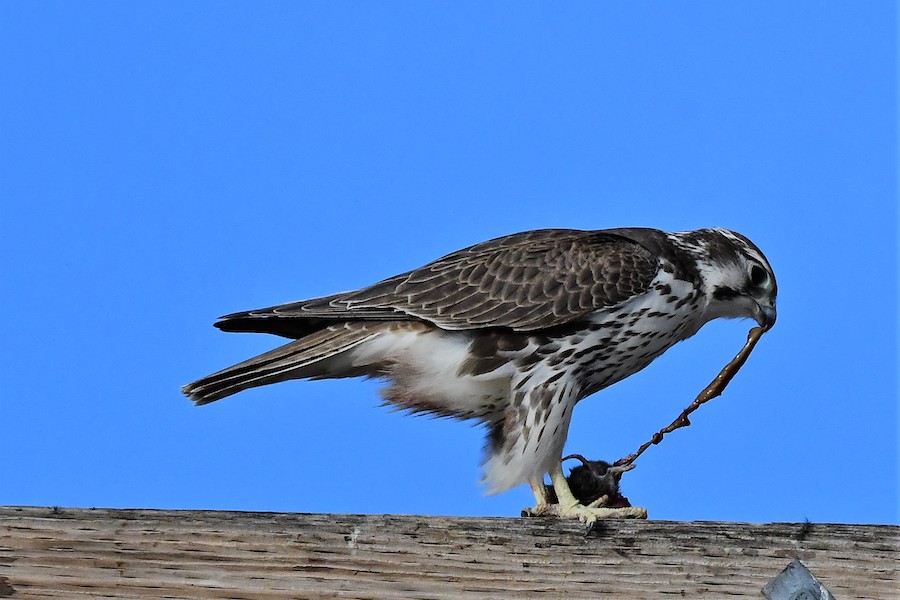Mud Lake has seen a lot of fowl play lately. Here’s what you might see the next time you’re there
Published at
It resembled a pro-wrestling tag team match. A Ferruginous Hawk caught a vole in the harvested alfalfa field and was immediately attacked by a recent arrival from Alaska — a Rough-legged Hawk. As the Ferruginous flew off with its catch and the bully close behind, I saw a smaller, sleeker bird diving toward the two hawks. It was a Prairie Falcon looking for a free meal.
The larger hawks could not maneuver away from the diving falcon and as the falcon passed under the Ferruginous, it flipped over and grabbed the vole from the larger hawk’s talons. I was lucky. It chose the power pole next to me to eat the stolen meal. The hawks gave chase but just circled me and the falcon as it methodically skinned, gutted and consumed the unlucky vole.
Meanwhile, the two hawks joined the other 200 to 300 hawks hunting the vole-rich hay stubble fields south of Mud Lake.
For the last two weeks, the road to the Mud Lake South Boat Ramp from State Highway 33, has been the gathering place for large numbers of hawks, ravens, crows and a few falcons. By the numbers of voles being caught by these birds, it appears that a vole population explosion had hit the farms south of Mud Lake. By glassing one field, I counted 17 birds feeding on the small rodents. The voles took advantage of the time between the migration of the Swainson’s Hawks to Central America and the recent arrival of the Rough-legged Hawks from nesting in the Arctic Circle, to become numerous.
With many of the hay farmers in the Mud Lake and Howe areas mowing their fields very short, they have removed most of the cover for rodents to hide from the raptors. These two areas will host hundreds, if not thousands, of raptors during the winter unless they run out of food. A mid-winter thaw coupled with a major rain event, followed by a bitterly cold spell, will destroy most of the rodent population and the raptors will have to find a new hunting area.

The raptor population near Mud Lake is made up of mostly Red-tailed Hawks with the Rough-legged being the second most numerous. There are more Ferruginous Hawks there than I have seen in that area before, with the area-nesting Northern Harriers, Prairie Falcons, Kestrels and an occasional Bald or Golden Eagle joining the fray. The scavenger birds (ravens, crows and magpies) are also attracted to the area to clean up the leftovers that fall or cast off from the raptor’s tables.
While the Rough-legged Hawks are long haul migrators, most of the Red-tailed Hawks are short migrators from nesting in the mountains and forests around us.
Watching these birds can be very entertaining as they soar, dive, argue, fight and steal each other’s captures. On sunny days when the sun heats the ground, updrafts will be created for groups of birds to practice their soaring and diving techniques. On Tuesday, I watched several groups of about 20 raptors soaring together, climbing two to three hundred feet in the air. A large murder of crows and ravens joined the hawks, creating a soaring party of over 100 birds putting on a show for me.

My favorite shows were the battles over food between species and sometimes the battles were replaced with birds sharing or giving their catch to another bird — must be the spirit of Thanksgiving even among them. I watched as a Prairie Falcon shared rodents twice with other Prairie Falcons (I wish I knew the story behind that relationship).
If you go out to watch this gathering, remember each of the hawk species has different “color phases” that will complicate their identifications. Ferruginous Hawks are claimed to be the largest hawks in Idaho with the Red-tailed being the second largest and I often get confused between the darker phases of those two species.
Also, be on the lookout for odd raptors. You may see a Goshawk or a Gyrfalcon mixed in among them. With birds, you can always be surprised.
Here’s to a safe and Happy Thanksgiving. Deer and elk are starting to migrate and with predicted storms. The roads may be slick.
Living the Wild Life is brought to you by The Healing Sanctuary.


